
Pursuing the Dream
You can make a lot of money in the slab lifting business. There are many markets to take advantage of, including Residential, Commercial-Industrial and Transportation. Let’s take a quick look at all three...
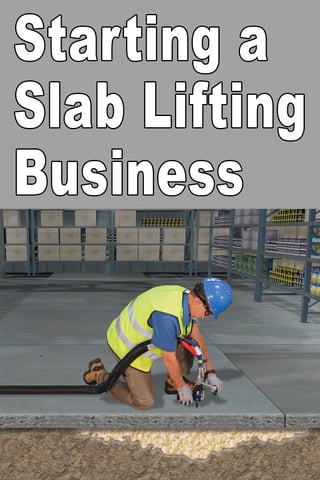 Residential Slab Jacking
Residential Slab Jacking
The residential market offers tremendous opportunities for the slab lifting contractor. Obviously there are driveways, foundations, patios, pools, and porches. Don’t think residential only includes houses. There are countless opportunities in the apartment and condo sectors as well.
Commercial-Industrial Slab Jacking
Because scenarios for slab lifting are infinite in the non-residential category, let’s lump Commercial and Industrial together. Concrete parking lots, showroom floors, industrial park walkways and an endless supply of huge warehouse floors are just the tip of the iceberg in this extremely lucrative field of opportunity.
Slab Jacking for the Transportation Sector
Last but not least, take a look in the transportation sector. The world is covered with miles and miles of concrete roads, highways, bridge approach slabs, and railroad support slabs. A large percentage of them have settled in one spot or another (and the rest are vulnerable to future settling). There will NEVER be enough slab lifting contractors out there to address ALL of these current and future slab lifting needs. Your fortune awaits...IF you know what you’re doing.
Avoiding the Nightmares
It would be irresponsible to paint a completely rosy picture of the business and neglect to warn you of the pitfalls. Risk is an underlying factor in any new endeavor, and slab lifting is no different. Threats of failure can arise from problems with your Equipment, your Lifting Material and your Technical Knowldege.
Equipment Problems
You don’t want to wing it when you put your lifting rig together. Seek the advice of an experienced technician to make sure you have all the equipment you need, reliable machinery, and a trailer rig that was built to haul it all around. The last thing you need is a hose bursting, a generator failing or (and this has happened) a trailer axle breaking on the day of your first job!
Lifting Material Problems
How would you like to spend your time working on jobs that actually pay? Using reliable polymers will cut way back on the chances you’ll have to load up your rig and waste a day re-doing a job you were paid for long ago.
Technical Problems
Here’s where it’s critical to partner with a knowledgable polymer supplier that cares about your success. Some who have gone before you failed at their new venture because they weren’t prepared to overcome common challenges that arise on slab lifting jobs. How do you deal with a slab that has fused to a wall or another slab and stubbornly refuses to lift? What about very small structures that easily leak polymer from underneath all sides without raising an inch? Then there’s the fun surprise of realizing the wrong side of your slab is lifting. You can also accidentally crack slabs, damage your customer’s proprty and - in the the biggest nightmare of them all - permanently overlift the slab.
A Realistic Guide to Slab Lifting Success
We can start you on the journey of total preparation for success in slab lifting. Our experienced technical consultants can educate you on the causes of settled slabs, the process of repairing them, and critical facts about the polymer material on which your jobs will rely. You'll learn about trailer rig options, the MixMaster slab lifting gun, pump options and accessory equipment. We also offer tips on markering your business, estimating materials for jobs, and essential techniques for avoiding on-the-job problems. To get started, call us today at 404-618-0438.
Want info Alchemy-Spetec slab lifting products?


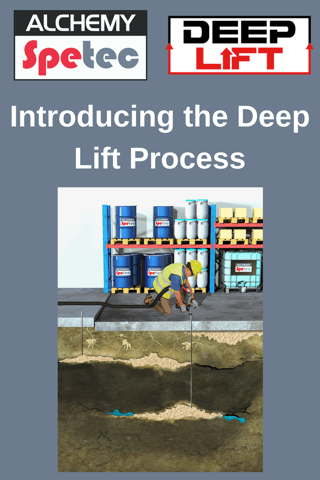 Poor compaction, water erosion, broken pipes, and organic material in the soil can all lead to settling of a foundation or a roadway. Traditional slab lifting can bring concrete and structures back into place but it doesn’t necessarily address the underlying issue or guarantee a long term fix. Other methods of addressing deep soil issues require heavy equipment, extended down time, and collateral property damage. These situations create problems for property owners as well as opportunities for the elite contractors that know how to fix them.
Poor compaction, water erosion, broken pipes, and organic material in the soil can all lead to settling of a foundation or a roadway. Traditional slab lifting can bring concrete and structures back into place but it doesn’t necessarily address the underlying issue or guarantee a long term fix. Other methods of addressing deep soil issues require heavy equipment, extended down time, and collateral property damage. These situations create problems for property owners as well as opportunities for the elite contractors that know how to fix them. 


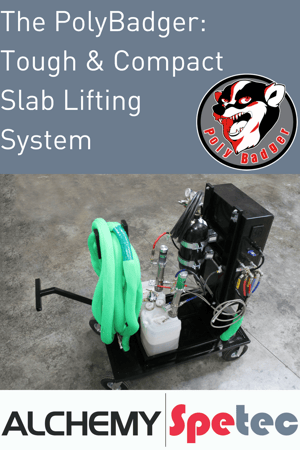 The Alchemy-Spetec PolyBadger lifting system is tough and compact. This system is an affordable entry-level slab lifting option for new contractors, as well as an extremely portable addition to the experienced contractor’s arsenal. The PolyBadger is a lot less expensive than your standard 20 foot trailer rig. The set up is simple and requires minimal equipment. The entire system can easily fit in the back of a pickup truck!
The Alchemy-Spetec PolyBadger lifting system is tough and compact. This system is an affordable entry-level slab lifting option for new contractors, as well as an extremely portable addition to the experienced contractor’s arsenal. The PolyBadger is a lot less expensive than your standard 20 foot trailer rig. The set up is simple and requires minimal equipment. The entire system can easily fit in the back of a pickup truck!
-1.png?width=1024&name=conference%20room%201-banner%20(4)-1.png)
.png?width=320&name=conference%20room%201-blog%20(6).png) “If you don’t love something, you’re not going to go the extra mile, work the extra weekend, challenge the status quo as much.” – Steve Jobs
“If you don’t love something, you’re not going to go the extra mile, work the extra weekend, challenge the status quo as much.” – Steve Jobs




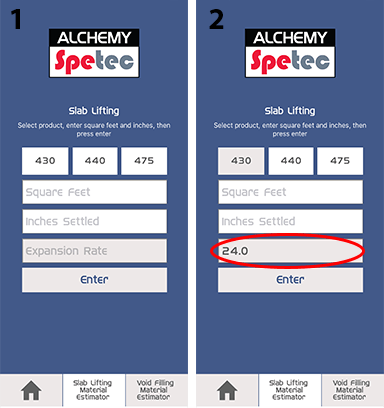
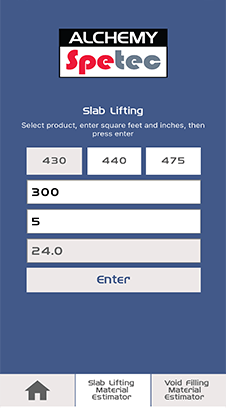 6. End Result
6. End Result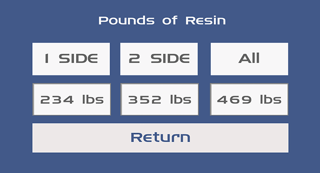
-1.png?width=1024&name=Polyurethane%20Soil%20Stabilization%20Explained-banner%20(1)-1.png)


.png?width=320&name=part%204-%20blog%20(1).png) The
The 


.png?width=1024&name=part%201%20(4).png)
.png?width=320&name=part%201%20(3).png)

.png?width=320&name=part%201%20(1).png)

 Residential Slab Jacking
Residential Slab Jacking
